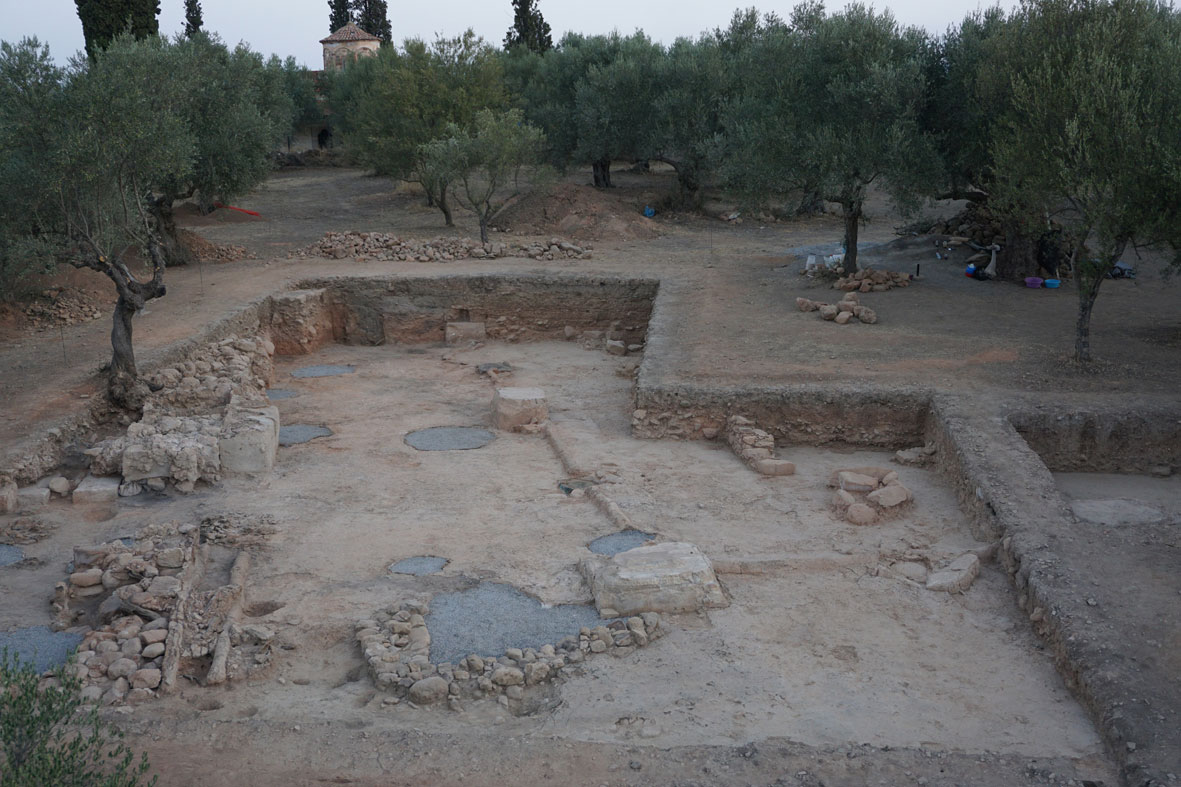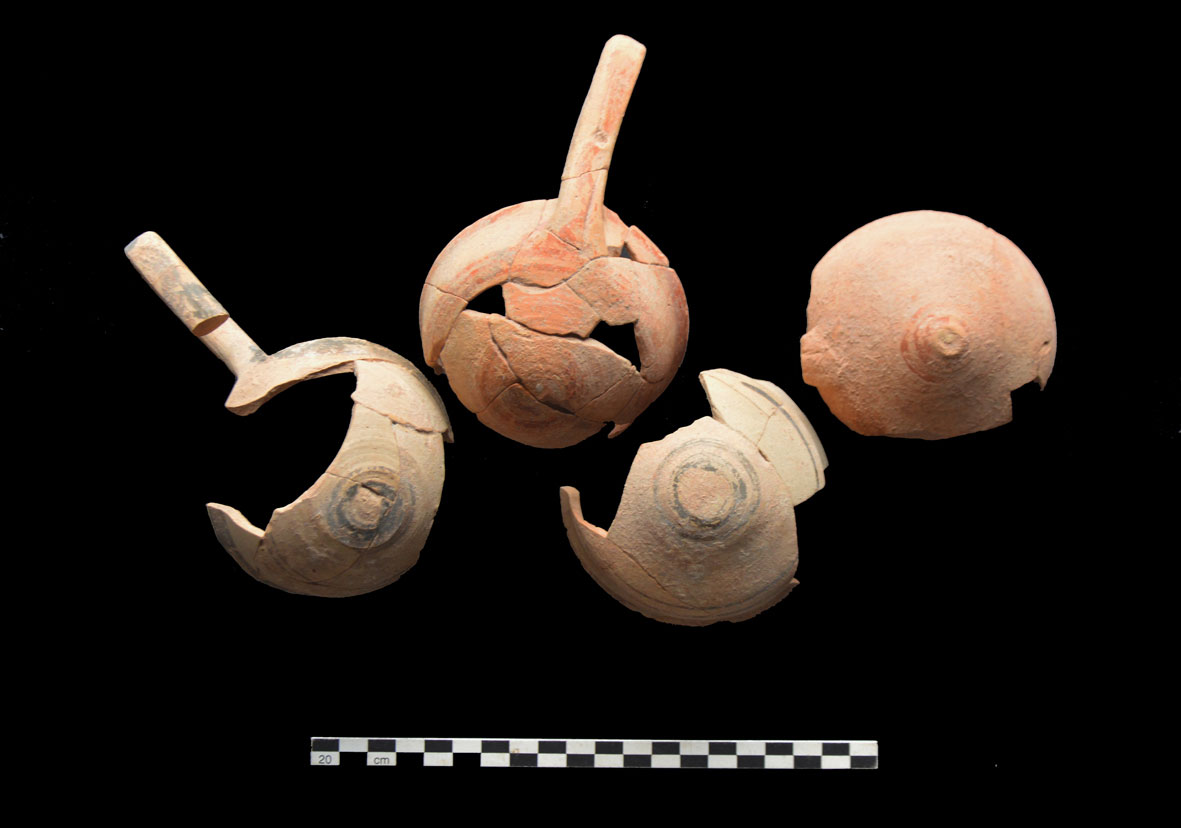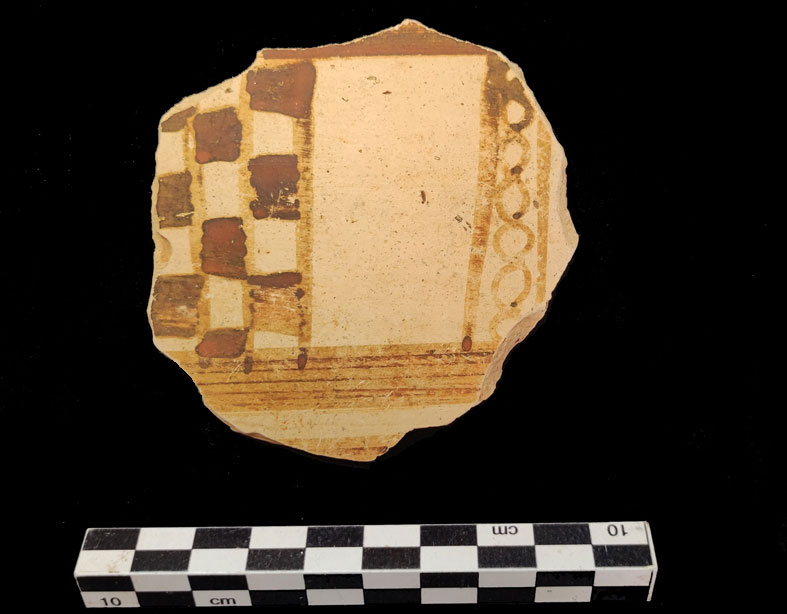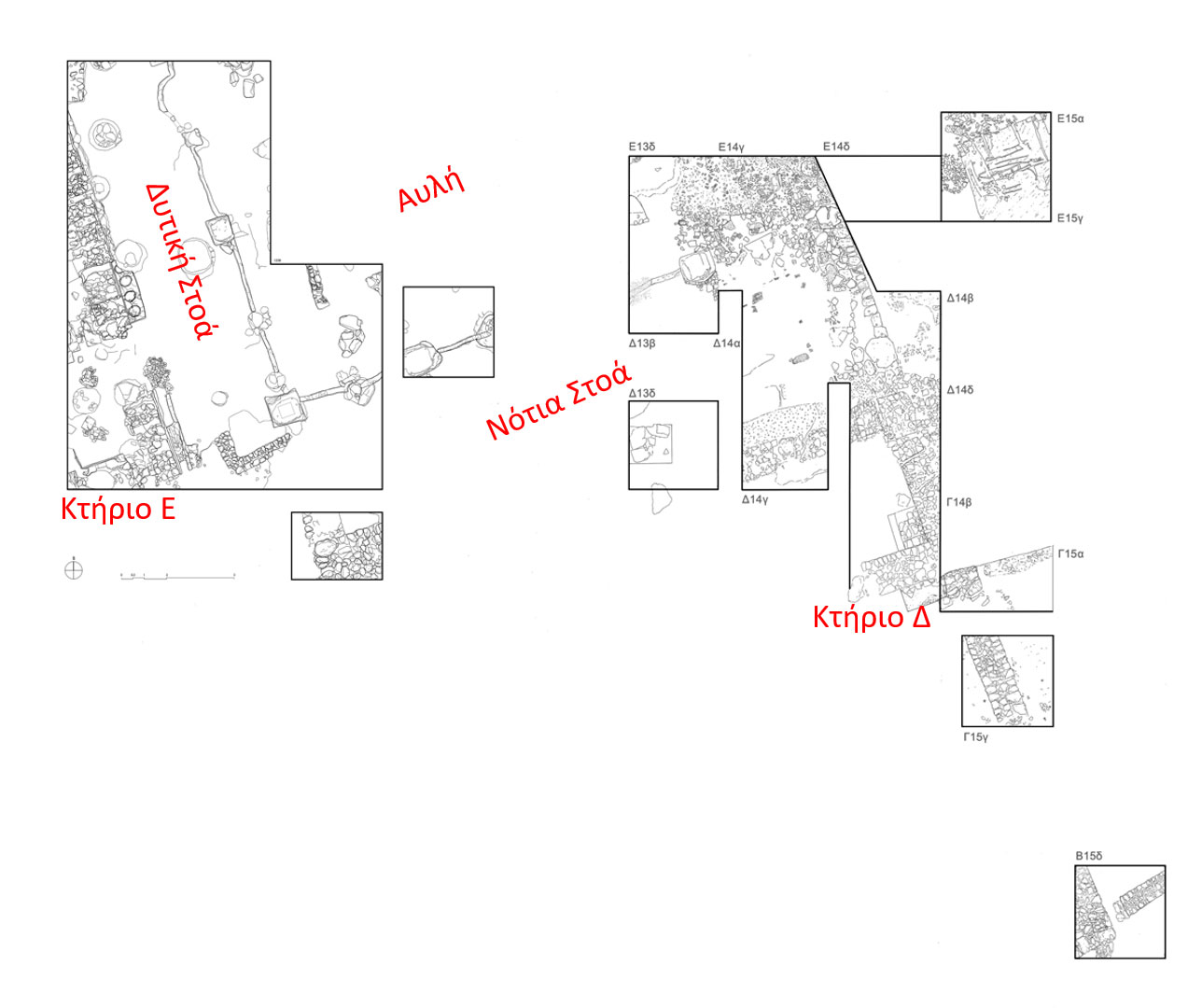The excavations in Sector III identified the remains of several large impressive structures. These include Building Delta, Building Epsilon and two Stoas (Fig. 1). Building Delta is located in the south-eastern part of Sector III. Only the east wall of this building and a small part of a room to the north-east have been excavated. The external east wall of the building is 26 m long, and the room was reoccupied during the Byzantine period. For this reason, a large part of the Late Helladic (LH) layers has been lost. The pottery recovered from two trial trenches has been dated to LH II and LH IIIA. But further excavation is needed to better understand the large structure referred to as Building Delta, to establish its plan and possible construction phases, as well as its connection with the other structures.
To the north of Building Delta, an open central courtyard of considerable size was found which was associated with two Stoas, the West and the South Stoa. Resistivity survey revealed a large complex of buildings extending out towards the east and west of the courtyard, on a north-west to south-east orientation. This layout points to Minoan influence, which is also indicated by other specific architectural features and construction techniques. The West and South Stoa are examples of monumental architecture that is unique to the Greek mainland during the Bronze Age.
The length of the South Stoa is around 25 m, while 17 m of the West Stoa has been excavated so far. On the side that faces the courtyard, the Stoas were supported by a colonnade of alternating pillars and wooden columns, while the rear walls were massive. The pillars were set on large quarried stone bases at 5 m intervals in the South Stoa, and 7 m intervals in the West Stoa, with a wooden column set in between. The pillars had either a rectangular or square form, with the largest measuring almost 1.5 m square and supporting the south-west corner of the two Stoas. Each Stoa was 5.5 m in width, comparable to those in Building T at Kommos on Crete, broad enough to constitute a sheltered part of the courtyard.

Fig. 2. The West Stoa at the end of excavation in 2021
The West Stoa is so far the most important building in Sector III (Fig. 2). In the northern part of the West Stoa, where the destruction debris was thicker, the fallen floor of an upper storey was discovered. It was here that the Linear B archive had been housed, along with storage pithoi. An entrance through the back wall of the West Stoa provided access to another structure, Building Epsilon, which according to the geophysical survey belonged to a large complex located to the west of the courtyard.
Chronology of the destruction
The ceramic material from the West Stoa that forms the basis for the dating of the destruction belongs to three different types of assemblage. The first comprises a group of 17 complete or nearly complete vessels that were lying directly on the ground floor of the stoa. The vessels were all plain and heavily burnt and found close to the opening of the West Stoa into one of the rooms of Building E, to the west and under the debris of the Stoa. The preservation and stratigraphic position of the vessels clearly show that these were in use at the time of the destruction (floor deposit in situ). The second group of vessels was almost all of the same small shape, namely the painted dipper. Seven such dippers were found in the red layer or in the debris from the collapse of the West Stoa, occasionally in concentrations. It is impossible to know where these pots were originally located, but the most likely explanation is that they were in one of the rooms of the first storey. They were probably incorporated within the red layer when the upper storey collapsed. Finally, the third group is the abundant sherd material that was mainly found in the red layer on top of the ground floor. These are redeposited and could date from either the construction or destruction phases of the palace.

Fig. 3. Dippers from the upper floor of the West Stoa
All of this material was statistically and typologically evaluated. The plain sherds from the floor deposit of the West Stoa are of typical drinking vessels, such as carinated kylikes (FS 267), angular bowls (FS 295) and shallow cups (FS 220). Many of these have the characteristic LH IIIB flared rims that are very rare in the earlier LH IIIA2 deposits at the site. The shallow cup group (FS 220) allows us to narrow down the date. This is especially the case with these types of cups, with their angular profiles and slightly thickened lips. Cups of this type are present from LH IIIB1 to LH IIIC Early 1, but the best parallels to the vessels from Ayios Vasileios come from Room 19 of the Temple Complex at Mycenae, which was deliberately sealed at the beginning of LH IIIB2. The material from Room 19 is arguably the assemblage of the building that was in use before or at the time when the LH IIIB Middle destruction struck Mycenae.
The typology of the painted pottery from the destruction debris and the red layer is consistent with the dating of the destruction event at Ayios Vasileios around the middle of the 13th century BC. LH IIIB Middle is best known from Mycenae and Tiryns, where the pottery bridges LH IIIB1 and LH IIIB2. Some vessels and sherds from the destruction debris of the West Stoa may belong to this phase, including two dippers (FS 236) with dotted rims (Fig. 3) and one sherd decorated with chequers and triglyph that probably came from a deep bowl (FS 284) of type B. The dippers with dotted rims have round bases and horizontal stripes on the handles. Dippers with this decoration rarely appear before LH IIIB, while stripes on the handles are more common during the second half of the 13th century.

Fig. 4. Sherd decorated with chequers and triglyph that probably came from a deep bowl
The sherd (Fig. 4) discussed here is decorated with chequers and triglyph, with a fill of attached circles. In this case, the chequers on the sherd from Ayios Vasileios probably represent one of the earliest examples of the use of this motif, which is otherwise most frequent in LH IIIC Early and rare in LH IIIB2.
A final point that supports the suggested dating is the extreme rarity of deep bowls in the destruction debris of the West Stoa, a shape that is represented only by the sherd with the chequer motif described above, along with a possible base. On the other hand, deep bowls were very frequent in the post-destruction layers excavated within the courtyard. The deep bowls from these layers date to the final part of LH IIIB and LH IIIC Early 1. Hence, the destruction of the West Stoa took place during a period of general unrest and may have occurred at approximately the same time as similar events at Mycenae and Tiryns during LH IIIB Middle. At Thebes, a number of buildings were also burnt down at the end of LH IIIB1.
